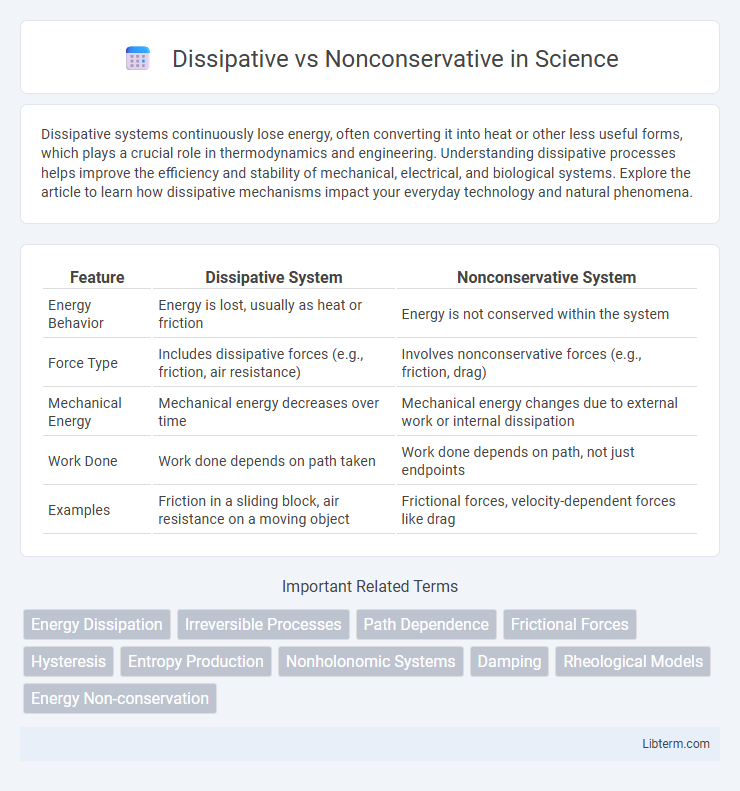Dissipative systems continuously lose energy, often converting it into heat or other less useful forms, which plays a crucial role in thermodynamics and engineering. Understanding dissipative processes helps improve the efficiency and stability of mechanical, electrical, and biological systems. Explore the article to learn how dissipative mechanisms impact your everyday technology and natural phenomena.
Table of Comparison
| Feature | Dissipative System | Nonconservative System |
|---|---|---|
| Energy Behavior | Energy is lost, usually as heat or friction | Energy is not conserved within the system |
| Force Type | Includes dissipative forces (e.g., friction, air resistance) | Involves nonconservative forces (e.g., friction, drag) |
| Mechanical Energy | Mechanical energy decreases over time | Mechanical energy changes due to external work or internal dissipation |
| Work Done | Work done depends on path taken | Work done depends on path, not just endpoints |
| Examples | Friction in a sliding block, air resistance on a moving object | Frictional forces, velocity-dependent forces like drag |
Understanding Dissipative Systems
Dissipative systems are characterized by the loss of energy, typically in the form of heat or friction, resulting in a decrease in the system's total mechanical energy over time. These systems contrast with nonconservative systems, where forces do not conserve mechanical energy despite no explicit energy dissipation. Understanding dissipative systems is crucial in fields such as thermodynamics, fluid dynamics, and mechanical engineering, where energy loss impacts system behavior and efficiency.
Defining Nonconservative Forces
Nonconservative forces are forces where the work done depends on the path taken between two points, causing energy dissipation through mechanisms such as friction, air resistance, or internal material deformation. Unlike conservative forces, nonconservative forces do not have a potential energy function and result in a net loss of mechanical energy from the system, typically converting it into heat or other non-recoverable forms. This characteristic distinguishes nonconservative forces as key factors in real-world energy transfer and dissipation processes.
Key Differences Between Dissipative and Nonconservative
Dissipative systems involve energy loss, typically converting mechanical energy into heat or other forms of energy, leading to a decrease in the system's total mechanical energy. Nonconservative forces, such as friction and air resistance, do not conserve mechanical energy, contrasting with conservative forces like gravity and spring force that allow energy to be fully recovered. Key differences include energy dissipation presence in dissipative systems versus energy conservation in nonconservative forces, influencing the system's stability and behavior over time.
Energy Transformation in Dissipative Systems
Dissipative systems transform mechanical energy into thermal energy or other non-recoverable forms, resulting in energy loss from the system. Unlike nonconservative systems, which conserve total mechanical energy, dissipative forces such as friction and air resistance convert usable energy into heat, reducing the system's mechanical energy over time. Energy transformation in dissipative systems is crucial in real-world applications like automotive braking and mechanical damping, where controlling energy dissipation affects performance and efficiency.
Work Done by Nonconservative Forces
Work done by nonconservative forces depends on the path taken and results in energy dissipation, often transforming mechanical energy into heat or sound. Unlike conservative forces, nonconservative forces such as friction and air resistance do not conserve mechanical energy within a system. The presence of nonconservative work causes a net change in the total mechanical energy, making the system's energy analysis dependent on the actual trajectory followed.
Real-World Examples of Dissipative Processes
Dissipative processes involve systems where energy is lost to the surroundings, often as heat or friction, such as in car brakes converting kinetic energy into thermal energy or in electrical resistors dissipating electrical energy as heat. Nonconservative forces, unlike conservative ones, do not conserve mechanical energy within the system, exemplified by air resistance slowing down a moving vehicle or friction between sliding surfaces. Real-world applications of dissipative processes include automotive brake systems, thermal energy loss in engines, and damping in building structures to reduce vibration.
Applications of Nonconservative Forces
Nonconservative forces, such as friction and air resistance, play a crucial role in engineering applications where energy dissipation is desirable, including braking systems in vehicles and vibration dampers in structures. These forces convert mechanical energy into other forms, like heat, effectively reducing system oscillations and preventing damage. In biomechanics, nonconservative forces model muscle fatigue and energy loss during motion, aiding in the design of prosthetics and rehabilitation devices.
Impact on Mechanical Energy Conservation
Dissipative forces, such as friction and air resistance, cause mechanical energy to be converted into thermal or other non-mechanical forms, leading to a loss in total mechanical energy and breaking the conservation principle. Nonconservative forces result in energy dissipation within the system, making mechanical energy non-conservative and requiring external work to maintain energy levels. In contrast, conservative forces, like gravity and spring forces, allow mechanical energy to be fully conserved, with energy merely transforming between kinetic and potential forms without loss.
Modeling Dissipative vs Nonconservative Dynamics
Modeling dissipative dynamics involves accounting for energy loss mechanisms such as friction, drag, and internal material damping, which cause system energy to decrease over time. Nonconservative dynamics describe forces that do not conserve mechanical energy, including external inputs or time-dependent forces, leading to complex behavior beyond conservative potential fields. Accurate simulation of these dynamics requires incorporating entropy production and nonpotential forces into mathematical models to predict real-world system evolution.
Practical Implications in Engineering and Physics
Dissipative systems, characterized by energy loss through friction or resistance, significantly impact engineering designs in mechanical and electrical systems by requiring energy input to maintain operation and affecting efficiency. Nonconservative forces, such as friction and air resistance, cause the total mechanical energy to decrease, necessitating continuous energy compensation in physical models and control systems. Understanding the distinction guides engineers in optimizing system durability, energy consumption, and predictive accuracy in dynamic simulations.
Dissipative Infographic

 libterm.com
libterm.com